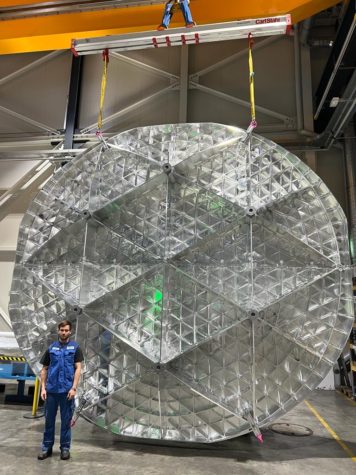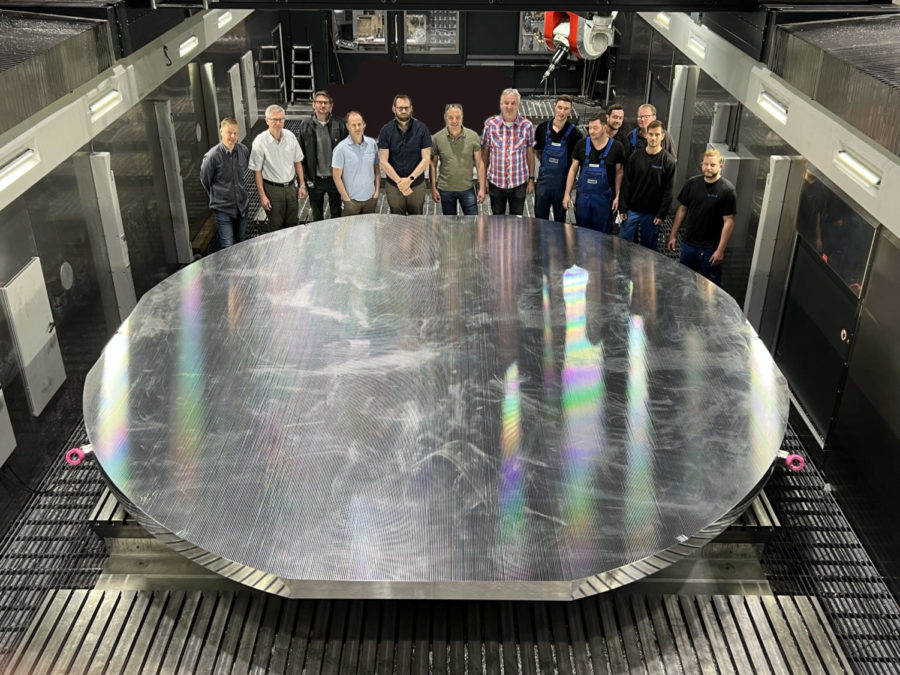On October 7, police escorted a wooden crate two lanes wide through the streets of the South Side, arriving at the new High Bay Research Building on East 56th Street and South Maryland Avenue.
Inside the crate? A carefully manufactured, 40-ton aluminum telescope reflector destined for the South Pole.
Making the trip from Germany by boat, too heavy to transport by plane, the reflector has come a long way to rest in the hands of the University’s best and brightest. It’s the first step of a larger project called CMB-S4, short for Cosmic Microwave Background Stage 4, the phenomenon it will observe. CMB-S4 will show pockets of space that scientists have just barely begun to explore.
The current telescope at the South Pole has been active since 2007, collecting data from the cosmic microwave background, which is the remnants of light from the early universe. Its “mirror” is made up of more than 200 small component mirrors, which can be adjusted to ensure the mathematical accuracy of the aperture curve or the angle of curvature of the telescope surface.
The current South Pole Telescope has already exceeded researchers’ expectations. But UChicago scientists remain ambitious, continuously creating new designs for detectors and mirrors in addition to updating old ones.
CMB-S4 is the brainchild of former UChicago research professor Steve Padin. In 2018, Padin published a paper arguing for a three-mirror telescope, the surface of which, rather than being made up of smaller panels, would be a single piece of metal crafted to have the correct surface angle at each point in the mirror.
After years of work by engineers and physicists and a proposal to the National Science Foundation, the South Pole Telescope (SPT) group received a $4 million grant to go forward with the idea.
Once the initial designs were finalized, the engineering challenge of actually building the telescope was allocated to Comcast, a manufacturing company based in Frankfurt, Germany. Over the 2021–22 academic year, the SPT team at Chicago and Comcast shared weekly calls to discuss challenges and share updates on the building process. Three University team members then flew out to Germany to inspect the final product in person.
Kavli Institute for Cosmological Physics associate fellow Tyler Natoli, one of the scientists sent to inspect the reflector, was interested in the engineering problems that required the collaboration of Chicago scientists and the team in Germany.
“We were very interested and invested in the subtle things like ‘How do you bolt the parts together? Do you use a key and groove system? Do you start bolting at the center and work your way out?’”
Every detail matters because for the reflector to be successful, the angle of the surface must be accurate to the order of 10 microns. For reference, the width of human hair is about 40 microns. This was just one detail of many that scientists had to perfect to obtain meaningful results.

Graduating from a combination of smaller, adjustable panels to one continuous aperture will ideally eliminate the interference of light in telescope images. In the current telescope, the microscopic amount of light that seeps through the gaps between each panel creates diffraction patterns in the camera lens, which compounds and produces a fuzzy image, especially for larger objects in space. If the new surface passes the tests, Natoli believes that clearer images for large and faraway objects in space could be obtained.
The reflector is yet to be unpacked from its crate in the High Bay Research Building. When it is, the SPT team will inspect the smoothness and angle of the surface to make sure it successfully survived the journey and can work in the larger construction of the CMB-S4 telescope. The full telescope will comprise three mirrors—two concave and one convex—with each mirror focusing the line to an even more precise degree than the last, correcting for optical uncertainties. This current reflector acts as a test case for the other two mirrors, which have yet to be constructed.
If this reflector runs smoothly, the team will move ahead with ordering the other two. If not, it’s back to the drawing board.
The entire construction for CMB-S4 is expected to take at least seven more years, leaving time for the construction of each reflector, the test assembly in a Texas desert, the delivery of the telescope to the South Pole, and its final assembly there. CMB-S4 will begin its real work in 2030 or even later, then collect data for about seven years. The process is long, but if the results are even half as good as scientists believe, it will be worth the wait.
Currently, SPT scientists are working on proving the theory of inflation, which hypothesizes that the universe started from an infinitesimal point—1/20 of a proton—and rapidly expanded at an exponential rate to where we are now.
“We should be able to see, in the fabric of spacetime, early universe ripples from this kind of violent start of inflation,” says Subramanyan Chandrasekhar Distinguished Service Professor of Astronomy and Astrophysics John Carlstrom, the principal investigator for SPT. “People have figured out that if those are there, we should be able to see them imprinted in the polarization.” By tracking the polarization of the CMB, SPT scientists can find evidence for the theory of inflation and dig deeper into the birth of the universe.
One of CMB-S4’s specific goals is the tracking of “things that pop” in front of the CMB canvas. As Tom Crawford, astronomy professor and scientist in the SPT group, describes, “We want to image transient sources, exploding objects, and objects that streak the sky, because we never thought about doing that with CMB telescopes. I can’t believe we’re seeing this deep.”
Despite the long road ahead for the SPT group in constructing CMB-S4, the team’s scientists remain optimistic, energetic, and excited about the future of SPT. Carlstrom shares in his colleagues’ enthusiasm, saying, “I’m looking forward to both answering the questions we’ve been asking for decades and getting excited about what we’re going to discover that we haven’t even thought of yet.”









